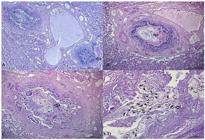ABSTRACT
The aim of this study was to investigate the occurrence of diseases in free-ranging wild canids that were roadkill on highways in the State of Espírito Santo, Brazil. PCR tests were performed for the detection of Brucella sp., Babesia sp., Rangelia sp., and Hepatozoon sp. in the spleen. Morphological evaluation and identification of parasites was performed in the liver and lung. Twenty specimens of C. thous were necropsied at the Animal Pathology Sector of the Veterinary Hospital of the Universidade Federal do Espírito Santo. Tissue samples were processed for histopathological examination and polymerase chain reaction (PCR) analysis. There was no PCR amplification of genomic DNA sequences of Brucella sp., Babesia sp., Rangelia sp., and Hepatozoon sp. using DNA extracted from the spleen as template. Histologically, lesions associated with parasitism by Platynosomum sp. and Angiostrongylus sp. were observed in the liver and lung, respectively. This is the first report of Platynosomum sp. and Angiostrongylus sp. parasitism in C. thous in the state of Espírito Santo, Brazil. Therefore, this study demonstrated parasitism of crab-eating foxes by Platynosomum sp. and Angiostrongylus sp. Importantly, no evidence of infection with Brucella sp., Babesia sp., Rangelia sp., and Hepatozoon sp. was obtained by PCR analysis.
Keywords:
wild canid; Histopathology; PCR

 Morphological and molecular diagnosis of diseases of free-ranging crab-eating foxes (Cerdocyon thous)
Morphological and molecular diagnosis of diseases of free-ranging crab-eating foxes (Cerdocyon thous) Thumbnail
Thumbnail
 Thumbnail
Thumbnail

